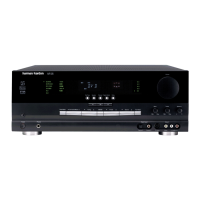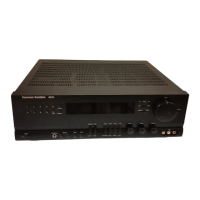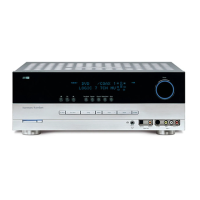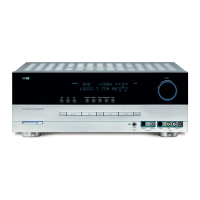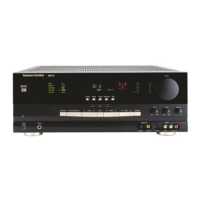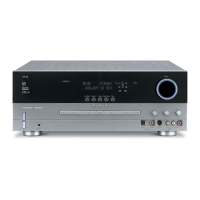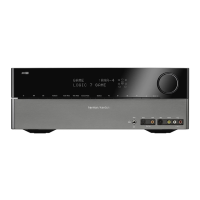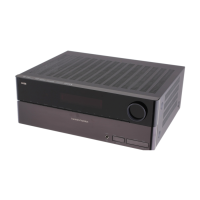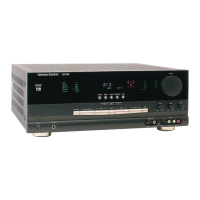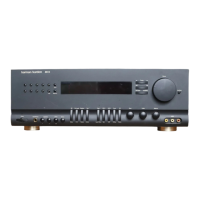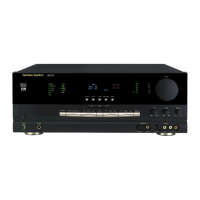
Do you have a question about the Harman Kardon AVR 220 and is the answer not in the manual?
| Channels | 5.1 |
|---|---|
| Total Harmonic Distortion (THD) | 0.07% |
| Frequency Response | 20 Hz - 20 kHz |
| Input Impedance | 47 kΩ |
| Weight | 7.2 kg |
| Type | AV Receiver |
| Input Sensitivity | 200mV |
| Video Connections | Composite, S-Video |
| Tuner Type | AM/FM |
| Speaker Load Impedance | 8 Ohms |
| Digital Inputs | Coaxial, Optical |
Overview of the AVR 220's versatility, listening options, and advanced capabilities like Logic 7 and VMAx.
Highlights onboard Dolby Digital and DTS decoding for six discrete audio channels.
Details Harman Kardon's proprietary Logic 7 and VMAX modes for enhanced sound fields.
Features the latest Dolby Pro Logic II decoding technology for surround sound.
Enables MP3 data decoding for playback from computers and digital audio players.
Explains the EzSet remote's function for automatically setting output levels.
Details front panel digital inputs for easy connection of portable devices.
Describes the on-screen menu and display system for setup and operation.
Covers the 6-channel direct input for external surround decoders.
Notes color-coded input, output, and speaker terminals for easy installation.
Covers essential safety guidelines including line voltage, extension cords, and cabinet opening.
Provides recommendations for unit placement to ensure proper operation and safety.
Details proper cleaning methods and procedures for moving the unit.
Includes FCC compliance information and guidelines for unpacking the unit.
Details the main power switch, system power control, and power indicator LED.
Covers controls for selecting audio/video sources and operating the tuner.
Describes the Bass, Balance, Treble, and Volume controls for sound adjustment.
Explains the front panel display and various mode indicator LEDs.
Details buttons for setup, surround mode selection, and system configuration.
Lists and describes the various input jacks on the front panel.
Identifies the remote sensor window for infrared signal reception.
Explains indicators for digital signal types like Bitstream, DTS, Dolby Digital, and PCM.
Details indicators for DSP, VMAX, Logic 7, Night Mode, and Tuned status.
Covers indicators for OSD, Memory, Stereo, Auto, Analog, Coaxial, and Optical inputs.
Describes indicators that show speaker configuration and digital input channels.
Details audio inputs (Tape, DVD, CD) and digital inputs/outputs (Optical, Coaxial).
Lists video connections including DVD, VCR, and monitor outputs.
Covers connections for Front, Surround speakers, AM/FM antennas, and 6-Channel Direct Input.
Describes switched/unswitched AC accessory outlets and the AC power cord connection.
Covers power on/off buttons, input selectors, and the AVR selector button.
Details buttons for selecting tuner bands, surround modes, and digital inputs.
Describes buttons for tuning stations, navigating menus, and entering data.
Explains buttons used for system setup, calibration (Test, SPL), and sleep functions.
Covers buttons for macros, punch-through, device functions, and system adjustments.
Provides initial steps for system setup after unpacking the unit.
Guides on connecting analog and digital audio sources and speakers.
Details how to connect various video sources like VCRs, DVD players, and TVs.
Explains how to connect the AC power cord and use accessory outlets.
Guides on choosing and positioning speakers for optimal sound reproduction.
Outlines the steps for setting up bass management, calibration, and delay times.
Details how to configure audio/video inputs and digital input assignments.
Explains how to select surround modes and adjust delay times for channels.
Describes the Night Mode feature for Dolby Digital sources to adjust dynamic range.
Guides on setting speaker types (Large/Small) and subwoofer configuration.
Covers adjusting output levels using EzSet or manual methods for optimal sound.
Provides detailed steps for manually adjusting output levels for each channel.
Explains how to configure additional settings for each input source.
Covers turning the unit on/off, source selection, and basic volume control.
A detailed chart explaining available surround modes and their features.
Instructions on how to select and use the fifteen available surround listening modes.
Explains digital audio formats like Dolby Digital, DTS, and PCM playback.
Guides on connecting and selecting digital audio sources for playback.
Details digital signal indicators and the Night Mode feature for Dolby Digital.
Covers playback of PCM (CDs) and MP3 audio formats.
Instructions for tuning AM, FM stations and managing presets.
Explains tape recording using outputs and output level trim adjustment.
Describes using the 6-Channel Direct Input and the memory backup system.
How to adjust the brightness of the front panel display, including turning it off.
Allows setting a default volume level for when the unit is turned on.
Covers enabling/disabling and setting the time-out for semi-OSD displays.
Explains how to adjust the time-out duration for the full-OSD menu system.
Step-by-step guide for programming the remote using direct three-digit codes.
Procedure for programming the remote when codes are not listed or do not work.
How to find the exact code entered for a device for future reference.
Enables programming sequences of commands into single button presses.
Allows certain functions to control another device without switching inputs.
Instructions on reassigning input selector buttons to operate different device types.
Procedure to reset the remote control to original factory defaults.
Steps to reset the unit's memory and microprocessor to clear operational problems.
